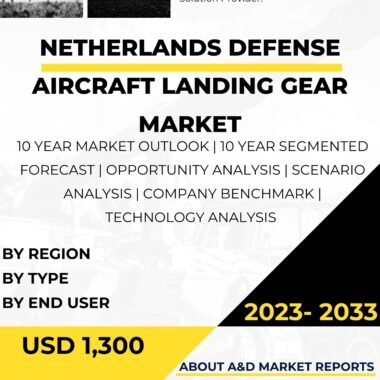Description
The United States landing gear market is a critical component of the country’s aerospace and defense industries. Landing gear is an essential part of an aircraft, providing support during takeoff, landing, and ground operations. As the U.S. military and commercial aviation sectors continue to evolve and modernize, the demand for advanced and reliable landing gear systems is on the rise.
The U.S. landing gear market is primarily driven by the constant need for safer and more efficient aircraft operations. The landing gear’s role in ensuring smooth landings, takeoffs, and ground movements is vital for passenger safety and operational success. Additionally, the increasing demand for air travel and the growth of the global aviation industry further amplify the importance of dependable and cutting-edge landing gear technology.
The U.S. military is a significant driver of the landing gear market, as it continuously upgrades and modernizes its fleet of aircraft. From fighter jets to cargo planes and helicopters, the landing gear is a crucial component that directly impacts mission success and the safety of military personnel. The U.S. Department of Defense (DoD) invests substantial resources in research and development to enhance landing gear systems’ performance and durability.
Moreover, the demand for innovative landing gear solutions stems from the need to optimize aircraft performance and reduce maintenance costs. The development of lightweight materials and advanced engineering techniques allows manufacturers to create landing gear systems that improve fuel efficiency, extend aircraft range, and reduce overall operational expenses.
The commercial aviation sector in the United States is also a significant contributor to the landing gear market. Airlines and aircraft manufacturers constantly seek landing gear technologies that enhance aircraft reliability, passenger comfort, and operational efficiency. The booming demand for air travel, driven by economic growth and globalization, fuels the need for high-performance and reliable landing gear systems that can withstand frequent takeoffs and landings.
In addition to military and commercial applications, the U.S. landing gear market is also influenced by the growth of unmanned aerial vehicles (UAVs) and other autonomous aircraft. The development of drone technologies for military and civilian purposes necessitates landing gear solutions that are adaptable to different aircraft sizes and configurations. As UAVs become more prevalent in various industries, landing gear manufacturers are exploring innovative designs to meet the unique requirements of these aircraft.
The U.S. landing gear market is characterized by intense competition and rapid technological advancements. Leading aerospace companies, both domestic and international, compete for contracts with the U.S. military and commercial aviation operators. In response to market demand and evolving regulations, landing gear manufacturers invest heavily in research and development to stay at the forefront of technology and innovation.
The focus on sustainability and environmental responsibility also influences the U.S. landing gear market. The aviation industry faces increasing pressure to reduce its carbon footprint and environmental impact. As a result, landing gear manufacturers are exploring ways to incorporate more sustainable materials and manufacturing processes into their products, contributing to the industry’s efforts to achieve greater eco-efficiency.
Furthermore, the U.S. landing gear market is affected by global geopolitical dynamics and international trade policies. Tariffs and trade restrictions can impact the supply chain and the cost of landing gear components, affecting both manufacturers and end-users. Close monitoring of international trade developments is crucial for landing gear companies to navigate potential challenges and uncertainties.
The U.S. government’s investment in defense and aerospace technologies significantly influences the landing gear market. Funding for military modernization programs and procurement contracts plays a vital role in supporting domestic landing gear manufacturers and ensuring that the U.S. military maintains a technological edge.
Collaboration and partnerships between landing gear manufacturers, aircraft OEMs, and research institutions are prevalent in the U.S. landing gear market. These collaborations foster knowledge sharing and accelerate the development of innovative landing gear solutions. Furthermore, partnerships with international aerospace companies enable U.S. manufacturers to access global markets and remain competitive on a global scale.
In conclusion, the U.S. landing gear market plays a crucial role in supporting the nation’s military and commercial aviation sectors. As technological advancements continue to drive the aerospace industry forward, landing gear manufacturers face the challenge of meeting evolving requirements for safety, efficiency, and sustainability. The market’s dynamic nature, influenced by military modernization, growing air travel demand, and technological innovation, requires landing gear companies to remain agile, adaptive, and at the cutting edge of aerospace engineering.




